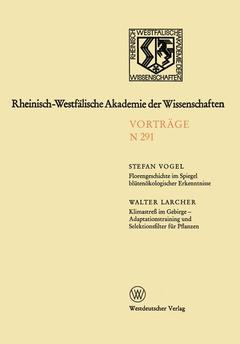Florengeschichte im Spiegel blütenökologischer Erkenntnisse, 1980 Rheinisch-Westfälische Akademie der Wissenschaften Series, Vol. 291
Langue : Anglais
Auteur : Vogel Stefan

The majority of flowering plants (angiosperms) make use, mostly in a strictly defined way, of animal pollen carriers which on their part depend on floral nourishment. Floral ecology distinguishes between several classes of flower adaptations with different geographic and historic dimensions. The nature of these mutual relations permits in certain cases to infer from the evolutionary level and the spatial distribution of one partner the history and paleogeography of the other. Thus, substantial indications may result which help to reconstruct the past of involved biota and communities. Parallel to other features of flowering plants, and arising from a minor degree of interrelation, zoophily (pollination by animals) has increasingly been perfected, specialised, and varied. Accordingly, higher developed pollinator groups evolved. Both processes interfered with the continental drift in the middle of the c. retaceous period. Primitive levels of adaptation, i. e. relations to early flower insects, were already present in the floras of the connected continental plates of the mesozoic (Gondwanaland), and widely scattered relics still exist, even dominating in some insular communities. In general, the evolution of higher elevated blossom types started only after the splitting of Gondwanaland and the isolation of the present continents. Thereby some peculiar traits of the interrelations emerged in the different geofloral regions, but also independent convergencies, part of which can only be explained by a certain preadaptation of a common ancestral group.
Florengeschichte im Spiegel blütenökologischer Erkenntnisse.- 1. Einleitung.- 2. Blütenstile als Ausdruck: adaptiver Radiation.- 3. Coëvolution der Partner und Rückschlüsse auf ihre Verbreitungsgeschichte.- 4. Blütenspezialisierung und Erdgeschichte.- 5. Florenreiche, blütenökologisch gesehen: Ähnlichkeiten und Eigenarten.- 6. Neue Synthesen aus Fremdkontakten.- 7. Blumenanpassungen pantropischer Familien: Problematik und mögliche Folgerungen.- 8. Einflüsse des Menschen.- 9. Ausblick.- Summary.- Literatur.- Diskussionsbeiträge.- Professor Dr. rer. nat. Meinhart H. Zenk.- Professor Dr. rer. nat. Stefan Vogel.- Professor Dr. phil. Maximilian Steiner.- Dipl.-Biol. Pedro Gerstberger.- Akad. Rat Dr. Klaus Kramer.- Professor Dr. med. Ludwig E. Feinendegen.- Klimastreß im Gebirge — Adaptationstraining und Selektionsfilter für Pflanzen.- Klimastreß im Gebirge.- Möglichkeiten der Anpassung an Klimastreß.- Anpassung der Pflanzen an das Temperaturklima im Hochgebirge.- Entwicklungsadaptationen bei Hochgebirgspflanzen.- Temperaturadaptationen des Betriebsstoffwechsels von Hochgebirgspflanzen.- Adaptationen der Temperaturresistenz von Gebirgspflanzen.- Summary.- Literatur.- Diskussionsbeiträge.- Professor Dr. rer. nat. Klaus Brinkmann.- Professor Mag. rer. nat. Dr. phil. Walter Larcher.- Professor Dr. rer. nat. Klaus Napp-Zinn.- Professor Dr. phil. Maximilian Steiner.- Dipl.-Biol. Pedro Gerstberger.- Professor Dr. rer. nat. Wilhelm Lauer.- Professor Dr. rer. nat. Meinhart H. Zenk.- Professor Dr. phil. Lothar Jaenicke.- Professor Dr. rer. nat. Dietrich Neumann.- Professor Dr. rer. nat. Kurt A. Santarius.
Ouvrage de 88 p.
Mots-clés :
Blüten; Entwicklung; Erkenntnis; Evolution; Pflanzen; Polle; Resistenz; Selektion; Stoffwechsel; pollination; Ähnlichkeit; Ökologie
© 2024 LAVOISIER S.A.S.



